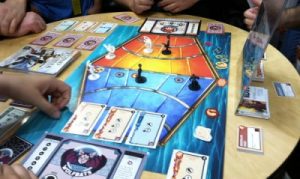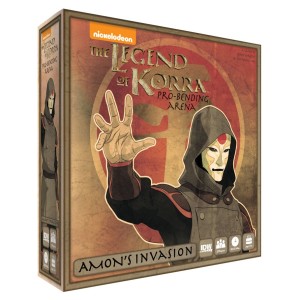Have you ever been in the middle of playing a game and thought or exclaimed aloud,“Who comes up with this stuff?!”
Well, I have! So I’ve reached out to several game designers to net some interviews to give you a privileged peek behind the game design curtain. In this case, we’ll be talking with designers Sen-Foong Lim and Jessey Wright whose powers combined with IDW games and The Legend of Korra IP to bring us The Legend of Korra: Pro-Bending Arena.
In this sweet new up-coming game, players will take control of three benders (one each of water, fire, and earth) and try to knock their opponents off of the pro-bending platform using the elements.
NOE: Before we get to asking you about The Legend of Korra: Pro-Bending Arena, we’d like to take just a second to get to know you both as nerds a bit. So what are your nerdy origin stories? What did you grow up loving and how did that help shape you into the nerdy dudes you are today?
SFL: Well, I was bitten by a radioactive spider,  see… truth be told, I started tabletop gaming at around 6 years of age when my mother couldn’t find things for me to do. So she let me play D&D with fully grown men at the local university. It started with D&D and quickly progressed to Titan, Car Wars, Champions, Villains & Vigilantes, etc. That eventually extended into lifestyle games like Magic: The Gathering and Warhammer 40K.
see… truth be told, I started tabletop gaming at around 6 years of age when my mother couldn’t find things for me to do. So she let me play D&D with fully grown men at the local university. It started with D&D and quickly progressed to Titan, Car Wars, Champions, Villains & Vigilantes, etc. That eventually extended into lifestyle games like Magic: The Gathering and Warhammer 40K.
When I needed to get more serious about my family and career, I switched to Eurogames – they filled the game incredibly well as you could play several games in a few hours without having to have weekly campaigns or spend time and money painting miniatures. Once I found them, I was hooked. I have since found the time to do some one-shot RPGs and my kids are starting to collect and play MtG and 40K so I get to keep abreast of those worlds as well.
I love comics, manga, anime as well and enjoy video gaming. I adore LEGO and live vicariously through my sons now as I tell everyone that I’m buying the LEGOs for them! I was a club DJ for many years, so I’m a vinyl nerd as well – I have around 10,000 records in my basement that I still play from time to time.
JW: I have been into video games since my family got an NES when it first came out. The first thing I bought myself after I got a job was a Gamecube. D&D has also been part of my weekly routine since I was about ten (which started when a friend got Hero Quest, and the rabbit hole took us to D&D). I start or join roleplaying groups whenever I move, and need a weekly fix of board gaming!
Board gaming started in university when I met someone who had hundreds of these cardboard games. We played Small World and I bought it the next day. The collection has grown ever since. Near the end of my bachelor’s degree, I got into design – just as a way to unwind after exams. When I moved to London I met Sen, and before long I was designing games with every bit of free time I had. I still play video games, and D&D (when I can, it’s a bit harder now), but most of my nerd time is now spent learning about, playing, and making board games.
NOE: Both of you have worked collaboratively on (or co-designed) games previously, but never together. How did you two come to be paired up for this game, and what strengths would each of you say the other brought to the game design process for Korra?
SFL: Jessey and I lived in the same city for several years, so we have a lot of games we co-designed together – this is the first of many to be published, we hope! Jessey is great at bringing chaos to my order. He is also tenacious – nothing is done until it’s done with him!
JW: The true origin story here is that I posted a game on BGG I was working on (a dexterity game) and Sen was crawling the BGG forums and saw it, noticed the flag under my avatar was a Canadian one, and so he sent me a Geek Message saying the game looked neat and he’d love to try it. I replied that I was just moving to London Ontario, but when I got there I could send him something to sample. Turns out Sen lived in London, so shipping was cheaper than expected. Within a couple years we went from gaming friends to co-designers. In part because Sen’s been a mentor to me with respect to designing games and getting them published.
As for strengths, I think the biggest thing Sen brings to our work is curve balls. I have a very narrow analytic mindset, and I puzzle out design problems and arrive at “optimal solutions”, while Sen’s mind is always churning up new wild and crazy ideas. While they may not stick, they often grow – through iteration – into core parts of the game.
NOE: I’m sure you sat down to the design process for Korra with some familiarity with the pro-bending matches from the cartoon. What mechanic (trying to avoid using the term “element” for obvious reasons!) or vibe to the contests were you most excited to translate into board game form?
SFL: The sense of teamwork was a huge beacon for me, personally. I wanted to ensure that you felt like using good team-based strategy was more effective than having one over-powered character.
JW: I wanted players to feel like benders. And not just because you were placing element tokens, but because how you placed the tokens and how the system worked drew you into it and you forgot, even for a moment, that you were playing a card game and thought instead you were blasting your opponent with water while dodging away from a trio of earth discs.
NOE: You two did a lot with the theme; doing so much more than applying an aesthetic and ruleset original to the show. One of my favorite things you incorporated was the sort of cheating system that involves yellow fan icons and the referee die. There is some fun risk/reward play in that! When in the design process did that idea surface? Was it intended from the outset, or did it present itself as a fun potential game mechanic further down the road?
SFL: Cheating was always a factor, I think. I mean, when you’ve got the Wolfbats as one of your two starter teams, cheating’s never far from your mind! We wanted to ensure teams were mechanically different and cheating opened up a lot of design space for us while also providing a really good decision point for players!
JW: I don’t have much more to add here, Sen hit all the nails. The cheating system itself actually didn’t change much over the design process. The biggest change it had was becoming a die (our prototype used a deck of 6 mini cards because we kept changing the probabilities and so that was easier to modify than restickering a die). As Sen says, we needed cheating to represent the Wolfbats correctly, so we opened up that space and gave a dash of it to every team. Then there are the cheating tricks which let players get really deep in the mud – if they want.
NOE: In The Legend of Korra, pro-bending worked kinda like boxing: You could win by executing a Knockout or by winning the most rounds of the three regulation rounds (all 3 had to be played barring a win by Knockout). Why did you two choose not to incorporate the match/round win condition set up in Pro-Bending Arena?
SFL: We wanted to keep the game quick enough that if you wanted to play 3 rounds, you could.
JW: We focused on making each pro-bending game as engaging and fun as we could, and so decided early on not to be concerned about a best of three format as that might distract us from making the core experience great. It totally can be best of three, and we recommend it be played that way in tournaments and events, but it doesn’t have to be and I think that flexibility is important.
NOE: Do each of the elements’ bending techniques feel and operate any differently during play?
SFL: That’s the hope! Each elemental bender type has some bonuses and unique icons that allows for each to feel special. Earth benders, for example, have less movement, can block attacks well, and often have shorter range on their attacks. Within the mechanical constraints, we were able to differentiate how each type of bender feels when you play them.
JW: Following up on Sen, we tried to give each bender a bit of a personality through their actions. You’ll notice some hit hard, and some hit wide, and some have a tendency to do strong close attacks while others make you feel like you just can’t get far enough away from them. Each element has one type of thing other elements don’t get (or get very, very rarely). Water benders are the only ones with “Follow Up” or, as I called them sometimes in testing, “Splash” attacks, and Fire benders rarely have an action that doesn’t allow them to move.
NOE: You’ve already developed an expansion to the game based around Amon’s Equalist invasion during the Pro-Bending Championships. What does the expansion add to the base game?
SFL: For one, it changes the mode of play from competitive to co-operative! Instead of a 1v1, it becomes a 2 vs an AI deck that dictates how Amon and his Equalist forces work. Each Equalist has a special weapon with some pretty nasty effects, which makes them interesting. I absolutely love the model of the moustachioed Equalist as well, so that helps! If that wasn’t enough, Amon and 2 of his Henchmen can also be used by a player against a Pro Bending team – there’s a lot of versatility in the box.
JW: There’s also a set of Avatar Korra cards which lets you use Korra in Avatar State as a solo bender, either against Amon, or as an epic special Pro Bending event.
NOE: The Kickstarter featured team cards, minis, and decks beyond the base game’s White Falls Wolfbats and Republic City Fire Ferrets. Hopefully we’ll see those retail soon; maybe as mini expansions a la IDW’s treatment of the Casey Jones/April O’Neil/Splinter expansions for TMNT: Shadows of the Past so we can take more full advantage of the Fantasy Team variant rules outlined in the rulebook. Regardless: Mind sharing your own individual Fantasy Team builds with us? Assuming all the teams shown on the Kickstarter page were on the table, which benders and team abilities do you choose to make your own A-Team?
SFL: Rabaroos would be in the mix for sure, and you need two of them to get their combo rolling. After that, I think I’d be really tempted to take a Wolfbat with a Daze effect so that I could first Rally a bunch with Ula’s “A Grain of Sand” cards then Blitz with Adi’s “Dragon Descending” or “Deal Jets” cards to allow Tanho to put the proverbial icing on the cake with his signature move, “Frozen Floor”!
JW: I change my preferences everytime I sit down. At the moment I’m feeling in the mood for a Tigerdillo / Buzzardwasp split. Probably one Tigerdillo, their special ability gives them cards that when you discard them for Chi they grant 2 instead of 1 with lets you ramp up your deck more quickly. Then, I’d compliment that with 2 Buzzardwasps, whose sting power drains 1 Chi from your opponent. With the Tigerdillo giving me extra Chi, and the wasps stinging away my opponent’s Chi, I should be able to fine tune a powerful endgame deck by the midgame, and my opponent will be lucky to have acquired one new card! The rest will be history at that point.
NOE: Lastly, what are you two nerding out on right now?
SFL: Batman: The Animated Series. For the 9th time.
JW: Monster Hunter: World.
The Legend of Korra: Pro-Bending Arena and its expansion, Amon’s Invasion, are both due out in the next couple of months, but you can read their instruction manuals in full right now (just click their titles above) to start falling in love early.
Fans of the show will undoubtedly love the game; not just because of the nostalgic aesthetics, but also for the attention to detail Jessey and Sen-Foong brought to their translation of pro-bending matches from your television to your tabletop.

